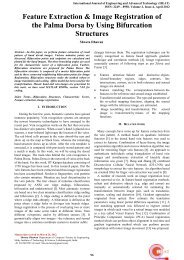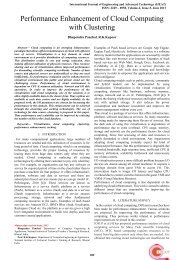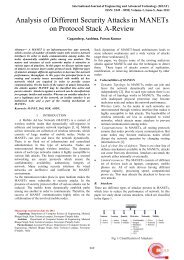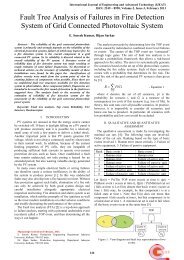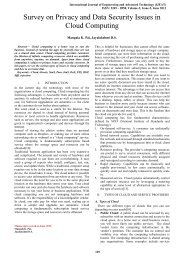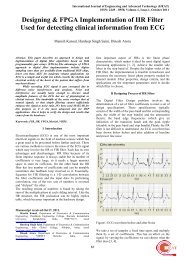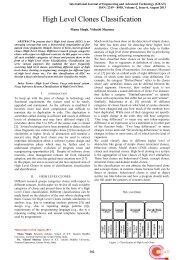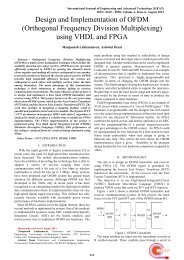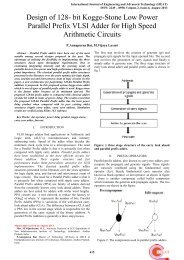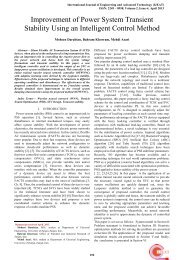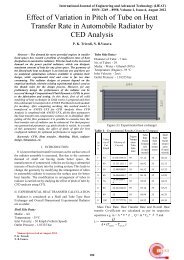Algorithm for Face Matching Using Normalized Cross-Correlation
Algorithm for Face Matching Using Normalized Cross-Correlation
Algorithm for Face Matching Using Normalized Cross-Correlation
Create successful ePaper yourself
Turn your PDF publications into a flip-book with our unique Google optimized e-Paper software.
International Journal of Engineering and Advanced Technology (IJEAT)ISSN: 2249 – 8958, Volume-2, Issue-4, April 2013<strong>Algorithm</strong> <strong>for</strong> <strong>Face</strong> <strong>Matching</strong> <strong>Using</strong> <strong>Normalized</strong><strong>Cross</strong>-<strong>Correlation</strong>C. Saravanan, M. SurenderAbstract— <strong>Face</strong> matching is the most important and crucialprocedure in face recognition. It is difficult to achieve robust facematching under a wide variety of different image capturingconditions, such as lighting changes, head-pose or view-anglevariations, expression variations, etc. Robust face matching isessential to the development of an illumination insensitive facerecognition system. This paper proposes a face matchingalgorithm that allows a template called extracted face of personwhich is the Region of Interest from one image and start search<strong>for</strong> matching with the different image of same person taken atdifferent times, from different viewpoints, or by different sensorsusing <strong>Normalized</strong> <strong>Cross</strong>-<strong>Correlation</strong> (NCC). The algorithm isimplemented in MATLAB. The experimental results show thatdeveloped algorithm is robust <strong>for</strong> similarity measure.Index Terms— <strong>Face</strong> <strong>Matching</strong>, <strong>Normalized</strong> <strong>Cross</strong>-<strong>Correlation</strong>(NCC), Region of Interest (ROI).I. INTRODUCTION<strong>Face</strong> matching is the most important and crucial procedurein face recognition. It is difficult to achieve robust facematching under a wide variety of different image capturingconditions, such as lighting changes, head-pose or view-anglevariations, expression variations, etc. Robust face matching isessential to the development of an illumination insensitiveface recognition system.There have been a number of methods proposed to achieverobust face recognition under different illuminationconditions. They can be roughly classified into threeapproaches; namely, the feature-based approach [14], [17],[11], [13], the appearance-based approach [15], [16], [4], [5],and a mixed approach [18], [10]. In the feature-basedapproach, it requires the extraction of the face feature pointsrobust against illumination variations. Extracted face edgemaps are then compared based on holistic similaritymeasures, such as the Hausdorff distance [12]. Many methodshave been presented <strong>for</strong> robust feature point extraction fromface images. For example, attention points are selected as thefeature points through the analysis of the outputs of the Gaborfiltered images. Points of maximum curvature or inflectionpoints of the shape of the image function were used as the facefeature points in [4]. For the comparison of edge maps, anManuscript received April, 2013.Dr. C. Saravanan, Head, Computer Centre dept., National Institute ofTechnology, Durgapur, West Bengal, India.M. Surender, In<strong>for</strong>mation Technology Dept., National Institute ofTechnology, Durgapur, West Bengal, India.affine coordinate based reprojection framework was proposedto match dense point sets between two input face images ofthe same individual in [11]. In the appearance-based facerecognition, the eigenface-based approach has been popular.To alleviate the illumination variation problem in theeigenface approach, it is common to ignore some of the mostdominant eigenfaces in the eigenface representation [17], dueto their strong relationship with illumination conditions.Recently, Georghiades et al. [13] proposed a new approach tocomparing face images under different illuminationconditions by introducing an illumination cone constructedfrom several images of the same person captured at the samepose under different illumination directions. Furthermore,Zhao and Chellappa [14] developed a shape- based facerecognition system through an illumination- independent ratioimage derived from applying symmetric shape-from-shadingto face images. In the mixed approach, face recognition isachieved by using a face model consists of face shape as wellas image intensity in<strong>for</strong>mation.In compared to above, this paper proposes a new facematching algorithm based on <strong>Normalized</strong> <strong>Cross</strong> <strong>Correlation</strong><strong>for</strong> matching the faces.II. LITERATURE SURVEY<strong>Cross</strong> <strong>Correlation</strong> is the basic statistical approach to imageregistration. It is used <strong>for</strong> template matching or patternrecognition. Template can be considered a sub-image fromthe reference image, and the image can be considered as asensed image. In [3] the authors has proposed a method ofmedical image registration by template matching based on<strong>Normalized</strong> <strong>Cross</strong>-<strong>Correlation</strong> (NCC) usingCauchy-Schwartz inequality. They have implemented thealgorithm <strong>for</strong> template matching using NCC in MATLAB.The developed algorithm was robust <strong>for</strong> similarity measure.They have showed experimental results with medical imagesregistration with noise and without Noise.In [2] the authors has proposed a fast pattern matchingalgorithm based on the normalized cross correlation (NCC)criterion by combining adaptive multilevel partition with thewinner update scheme to achieve very efficient search. Thiswinner update scheme is applied in conjunction with an upperbound <strong>for</strong> the cross correlation derived fromCauchy–Schwarz inequality. To apply the winner updatescheme in an efficient way, they have partitioned thesummation of cross correlation into different levels with thepartition order determined by the gradient energies of thepartitioned regions in the template. Thus this winner updatescheme in conjunction with the upper bound <strong>for</strong> NCC could930
<strong>Algorithm</strong> For <strong>Face</strong> <strong>Matching</strong> <strong>Using</strong> <strong>Normalized</strong> <strong>Cross</strong>-<strong>Correlation</strong>be employed to skip unnecessary calculation. Experimentalresults showed the proposed algorithm has very efficient <strong>for</strong>image matching under different lighting conditions.In [1], the author has proposed a combined approach toenhance the per<strong>for</strong>mance of template matching system usingimage pyramid in conjunction with Sum of AbsoluteDifference (SAD) similarity measure. Based on results it wasfound that the capabilities provided by the proposed methodsignificantly improved the accuracy and execution time oftemplate matching system. The experimental investigationswere based on the use of color and gray scale images withdifferent sizes and illumination.The paper [5] has presented a robust and efficient matchingmethod <strong>for</strong> face sequences obtained from videos. <strong>Face</strong>in<strong>for</strong>mation is quite important especially <strong>for</strong> news programs,dramas, and movies. <strong>Face</strong> sequence matching <strong>for</strong> such videosenables many multimedia applications including contentbased face retrieval, automated face annotation, automatedvideo authoring, etc. However, face sequences in videos aresubject to variation in lighting condition, pose, faceexpression, etc., which cause difficulty in face matching.These problems were tackled to achieve robust face sequencematching applicable to real video domains, and its efficientimplementation is presented. The paper proved the proposedmethod achieves good per<strong>for</strong>mance in actual video domains.In addition, by the combination with the high dimensionalindex structure, the algorithm achieved practicalcomputational time, as well as scalability against increase ofthe number of faces.In [6], the authors have presented a review of recent as well asclassic image registration methods in paper ―Imageregistrations method: A survey‖. The reviewed approacheswere classified according to their nature (area based andfeature-based) and according to four basic steps of imageregistration procedure: feature detection, feature matching,mapping function design, and image trans<strong>for</strong>mation andresampling. Main contributions, advantages, and drawbacksof the methods were mentioned in the paper. Problematicissues of image registration and outlook <strong>for</strong> the futureresearch were discussed too. The major goal of the paper wasto provide a comprehensive reference source <strong>for</strong> theresearchers involved in image registration, regardless ofparticular application areas.From the review of literature it is observed that thetemplate matching algorithm based on <strong>Normalized</strong><strong>Cross</strong>-<strong>Correlation</strong> is the best approach <strong>for</strong> matching thetemplate with same image accurately. In this paper weproposed a face matching algorithm based on <strong>Normalized</strong><strong>Cross</strong>-<strong>Correlation</strong> and used to matching the extracted face ofthe person from one image, with the different images of sameperson. The rest of this paper is organized as follows. Wedescribe the proposed face matching algorithm in the nextsection. We show some experimental results in section 5,finally, we conclude in the last section.III. CROSS-CORRELATION<strong>Correlation</strong> is an important tool in image processing, patternrecognition, and other fields. The use of cross-correlation <strong>for</strong>template matching is motivated by the distance measure(squared Euclidean distance) [8], [9]Where f is the target image and t is the feature, the sum isover x,y under the window containing the feature t positionedat( u, v). In the expansion of d 2(1)+ (2)The term is constant. If theterm is approximately constant, then the remainingcross-correlation termis a measure of the similarity between the image and thefeature.<strong>Normalized</strong> <strong>Cross</strong>-<strong>Correlation</strong>There are several disadvantages to using (3) <strong>for</strong> templatematching:(3) If the image energy varies with position,matching using (3) can fail. For example, thecorrelation between the feature and an exactlymatching region in the image may be less than thecorrelation between the feature and a bright spot.The range of c(u, v) is dependent on the size of thefeature.Eq. (1) is not invariant to changes in imageamplitude such as those caused by changing lightingconditions across the image sequence.The correlation coefficient overcomes these difficulties bynormalizing the image and feature vectors to unit length,yielding a cosine-like correlation coefficientWhere is the mean of the feature and is the meanof f(x, y) in the region under the feature. We refer to (4)as <strong>Normalized</strong> <strong>Cross</strong>-<strong>Correlation</strong>.(4)IV. PROPOSED FACE MATCHING TECHNIQUE<strong>Face</strong> matching system involved 2 stages of operation (1): Firststage is the model registration which is931
International Journal of Engineering and Advanced Technology (IJEAT)ISSN: 2249 – 8958, Volume-2, Issue-4, April 2013concerned with the storage of an image with computermemory. (2): Second stage is the process of searching <strong>for</strong> anextracted face in an image. This study is mainly focused onthe latter process of template matching system [6], [7].The following is the face matching algorithm <strong>for</strong> matchingthe extracted face with the different images of same person,which are taken at different times, from different viewpoints,or by different sensors.<strong>Algorithm</strong>1. Read the source image, and Extract the ROI from thesource face image. ROI will be the sub image, and must besmaller than the Target image.2. Do <strong>Normalized</strong> <strong>Cross</strong>-<strong>Correlation</strong> and find Coordinates ofPeak with the ROI and Target images. Calculate thenormalized cross-correlation and display it as a surface plot.The peak of the cross-correlation matrix occurs where the subimages are best correlated.3. Find the total offset between the images. The total offset ortranslation between images depends on the location of thepeak in the cross correlation matrix, and on the size andposition of the sub images.4. Check if the face is extracted from the target Image. Figureout where face exactly matches inside of target image.5. Pad the face image to the size of the target image using theoffset determined in step 3.6. Use Alpha blending to show images together. Display oneplane of the face image with the target image using alphablending.The above detailed algorithm is also shown pictorially asshown in the fig 1.First we have taken a source image of size 512X512as shown in the figure 2(a), and an extracted face of size80x80 from the source image by using Region of Interest asshown in the figure 2.(b). Target image of size 512x512 asshown in figure 2.(c) is chosen from the image database whichconsists of different images of same person taken at differenttimes, from different viewpoints. Now select the sub region ofboth extracted face and target images. Finally <strong>Normalized</strong><strong>Cross</strong> <strong>Correlation</strong> is per<strong>for</strong>med on these images. Figure 2.(e)shows the perfect matching of extracted face with the targetimage with the maximum NCC value. The plot of NCC is alsoshown in a figure 2. (d).Fig 2(a)Sourceimage(d)NCC plot(b) extractedface(Region ofInterest) fromsource image(c)Target image(e)perfect matching ofextracted face withtarget imageFig 3(a)Source image(b)extractedface(Region ofInterest) fromsource image(c)Target imageV. RESULTSWe present the results <strong>for</strong> the proposed algorithm. Theexperiments are conducted on color images of various sizes.Different sizes of faces are extracted from the source imagesby using Region of Interest, and search <strong>for</strong> matching with thedifferent images.(d)NCC plot(e)perfect matchingof extracted facewith target image932
<strong>Algorithm</strong> For <strong>Face</strong> <strong>Matching</strong> <strong>Using</strong> <strong>Normalized</strong> <strong>Cross</strong>-<strong>Correlation</strong>VI. CONCLUSIONFig 4(a)Source image(b)extractedface(Region ofInterest) fromsource image(c)Target imageWe have proposed a face matching algorithm, based on<strong>Normalized</strong> <strong>Cross</strong> <strong>Correlation</strong> <strong>for</strong> matching extracted face ofperson from source image with the different target images ofsame person. By observing the results, it is clear that<strong>Normalized</strong> <strong>Cross</strong>-<strong>Correlation</strong> (NCC) is the best approach <strong>for</strong>face matching. It gives perfect face matching in the giventarget image. The Maximum <strong>Cross</strong>-correlation coefficientvalues indicate the perfect matching of extracted face with thetarget image. This approach gives registered face image, if thesensed images do not have any rotation or scaling.(d)NCC plot(e)Not matchedwith the targetimageTable 1: NCC value <strong>for</strong> different extracted faces (ROI)with different Target imagesSl.No.Extractedface (ROI)sizeTarget Image1 60x80 Image 1 (512x512)Image 2 (512x512)Image 3 (512x512)Image 4(512x512)2 75x85 Image 1 (512x512)Image 2 (512x512)Image 3 (512x512)Image 4(512x512)3 85x100 Image 1 (512x512)Image 2 (512x512)Image 3 (512x512)Image 4(512x512)4 95x115 Image 1 (512x512)Image 2 (512x512)Image 3 (512x512)Image 4(512x512)NCC value0.99960.99830.99950.73570.99970.99910.99950.71250.99970.99910.98950.72870.99970.99910.98950.6983Table 1 show that different sizes of extracted faces (ROI) aretaken <strong>for</strong> matching with different target images and their NCCvalue is also given in the table. The first three images whoseNCC value is greater than 0.9, and are perfectly matched withthe extracted face images, but the last image in all fourexperiments, whose NCC value is less than 0.75, and is notperfectly matched with the target image due to low brightnessor contrast, but we can consider <strong>for</strong> the match. From the aboveresults, it is observed that the extracted face not matches withthe target image, if its NCC value is less than 0.6.REFERENCES[1] Fawaz Alsaade, ―Fast and accurate template matching algorithm basedon image pyramid and sum of absolute difference similarity measure‖.Research Journal of in<strong>for</strong>mation Technology Vol. 4, No.4, pp.204-211,2012.[2] Shou-Der Wei and Shang-Hong Lai,‖ Fast template matchingalgorithm based on normalized cross correlation with adaptivemultilevel winner update‖, IEEE Transactions on Image Processing,Vol. 17, No. 11, Nov. 2008.[3] Jignesh N Sarvaiya, Dr. Suprava Patnaik, and Salman Bombaywala,‖Image Registration by Template <strong>Matching</strong> using <strong>Normalized</strong> <strong>Cross</strong><strong>Correlation</strong>‖, International Conference on Advances Computing,Control, Telecommunication Technologies, pp. 819-822, 2009.[4] Minoru Mori and Kunio Kashino, ―Fast Template <strong>Matching</strong> based on<strong>Normalized</strong> <strong>Cross</strong> <strong>Correlation</strong> using Adaptive Block Partitioning andInitial Threshold Estimation‖ IEEE International Symposium onMultimedia, pp. 196-203, 2010.[5] Satoh, Shin'ichi ; Katayama, Norio ―An efficient evolution andimplementation of robust face sequence matching‖, Internationalconference on Image analysis and processing, pp. 266-271, 1999.[6] Barbara Zitova, Jan Flusser, ―Image Registration Methods: a Survey‖,Image Vision Computing 21, PP. 977-1000, 2003.[7] S. Damas, O. Cordon, and J. Santamaria, ―Medical Image registrationusing Evolutionary Computation: An Experimental Survey‖, IEEEComputational Intelligence Magazine, Nov. 2011.[8] Yufan Wang, Qiuze Yu, Wenxian Yu, ―An Improved <strong>Normalized</strong><strong>Cross</strong> <strong>Correlation</strong> algorithm <strong>for</strong> SAR Image Registration‖, IEEEIGARSS, 2012.[9] Vanderbrug, G.J, Rosenfeld, ―Two-Stage Template <strong>Matching</strong>,‖ IEEETransactions on Computers, Vol. 60, Issue 11, 1977.[10] G. J. Edwards, C. J. Taylor, and T. F. Cootes, ―Interpreting face imagesusing active appearance models‖, Proc. Third IEEE Conf. onAutomatic <strong>Face</strong> and Gesture Recognition, pp. 300-305, 1998.[11] K. Sengupta and J. Ohya, ―An affine coordinate based algorithm <strong>for</strong>reprojecting the human face <strong>for</strong> identification tasks’’, Proc.International Conference on Image Processing, Vol. 3, pp. 340 -343,1997[12] B. Takacs and H. Wechsler, ―<strong>Face</strong> recognition using binary imagemetrics‖, Proc. Third IEEE Conf. Automatic <strong>Face</strong> and GestureRecognition, pp. 294-299, 1998[13] A. S. Georghiades, D. J. Kriegman, P. N. Belhumeur, ―From Few toMany: illumination Cone Models <strong>for</strong> <strong>Face</strong> Recognition under VariableLighting and Pose‖, IEEE Trans. Pattern Analysis Mach. Intel., Vol.23, No. 6, pp.[14] S. Belongie, J. Malik, and J. Puzicha, ―<strong>Matching</strong> shapes‖, Proc. Int.Conf. Computer Vision, pp.454-461 , 2001.[15] X. Mu, M. Artiklar, M. H. Hassoun, and P. Watta, ―Trainingalgorithms <strong>for</strong> robust face recognition using a template-matchingapproach‖, Proc. Int. Joint Conf. Neural Networks,pp.2877-2882,2001.[16] P. Gros, ―Color illumination models <strong>for</strong> image matching andindexing‖, Proc. Int. Conf. Pattern Recognition, Vol. 3, pp.576-579,2000[17] Y. Adini, Y. Moses, and S. Ullman, ―<strong>Face</strong> recognition: the problem ofcompensating <strong>for</strong> changes in illumination direction‖, IEEE Trans.Pattern Analysis Mach. Intel., vol. 19, No. 7, July 1997.[18] L. Wiskott, J.-M. Fellous, N. Kuiger, C. von der Malsburg, ―<strong>Face</strong>recognition by elastic bunch graph matching‖, IEEE Trans. PAMI,Vol. 19, No. 7, pp. 775 - 779,1997.933
International Journal of Engineering and Advanced Technology (IJEAT)ISSN: 2249 – 8958, Volume-2, Issue-4, April 2013C. Saravanan received Ph.D.degree in Analysis and Modelling ofGray-Scale Image Compressionfrom National Institute ofTechnology, Tiruchirappalli,Tamilnadu, India in 2009. Hisresearch interest includes imagecompression, colour imageprocessing, medical image proce--ssing fingerprint analysis, and any image processing relatedareas. He has published 20 research articles in internationaland national journals, conferences, chapters in books. Hestarted his career with the Bharathidasan University,Tiruchirappalli, Tamilnadu, India, in 1996. He continued hiscareer with the National Institute of Technology,Tiruchirappalli, Tamilnadu, India. At present he is working asan Assistant Professor (System Manager) and HOD ofComputer Centre at National Institute of Technology,Durgapur, West Bengal, India. He is a life member ofComputer Society of India and Indian Society <strong>for</strong> TechnicalEducation, member of IEEE, member of ACM, member ofICSTE, IAENG.M. Surender received his B.Techdegree in In<strong>for</strong>mation Technology fromJyothishmathi Institute of Technology& science (JNTUH), Karimnagar,Andrapradesh in 2009. He is currentlypursuing M.Tech degree in In<strong>for</strong>mationSecurity at National Institute ofTechnology, Durgapur, West Bengal,during 2011-13, and currently working on Digital ImageProcessing area.He has published one Inter National Journal,and two National Conference papers. His Research areas ofInterests include Digital Image Processing, C programming,<strong>Algorithm</strong>s, and compiler design.934



